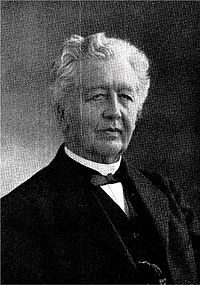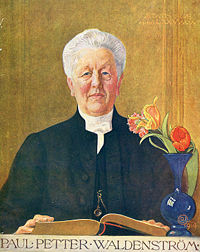
Paul Petter Waldenström
Encyclopedia


Free church
The term "free church" refers to a Christian denomination that is intrinsically separated from government . A free church does not define government policy, nor have governments define church policy or theology, nor seeks or receives government endorsement or funding for its general mission...
movement in late 19th century Sweden
Sweden
Sweden , officially the Kingdom of Sweden , is a Nordic country on the Scandinavian Peninsula in Northern Europe. Sweden borders with Norway and Finland and is connected to Denmark by a bridge-tunnel across the Öresund....
.
Waldenström was born in Luleå
Luleå
- Transportation :Local buses are run by .A passenger train service is available from Luleå Centralstation on Sweden's national SJ railway service northbound to Narvik on the Norwegian coast, or southbound to Stockholm. See Rail transport in Sweden....
in northern Sweden, son of a district physician. He began his academic studies at Uppsala University
Uppsala University
Uppsala University is a research university in Uppsala, Sweden, and is the oldest university in Scandinavia, founded in 1477. It consistently ranks among the best universities in Northern Europe in international rankings and is generally considered one of the most prestigious institutions of...
in 1857, completed his Ph.D. degree there in 1863, and was ordained a clergyman in 1864. He had been employed as an adjunct
Adjunct
Adjunct may refer to:* Adjunct , words used as modifiers* Adjunct professor, a professor who does not hold a permanent position at a particular academic institution* Adjuncts, sources of sugar used in brewing...
in the Växjö högre allmänna läroverk (the secondary school in Växjö
Växjö
Växjö is a city and the seat of Växjö Municipality, Kronoberg County, Sweden with 64 200 inhabitants in 2010. It is the administrative, cultural and industrial centre of Kronoberg County. Furthermore it is the episcopal see of the Diocese of Växjö. It has a population of about 64 200, out of a...
) already in 1862 and in 1864, when his doctorate qualified him for this, received a lecturer
Lecturer
Lecturer is an academic rank. In the United Kingdom, lecturer is a position at a university or similar institution, often held by academics in their early career stages, who lead research groups and supervise research students, as well as teach...
ship in Christianity, Greek and Hebrew at the secondary school in Umeå
Umeå
- Transport :The road infrastructure in Umeå is well-developed, with two European highways passing through the city. About 4 km from the city centre is the Umeå City Airport...
. From 1874 until 1905 he was lecturer in the same subjects at the secondary school in Gävle
Gävle
Gävle is a city in Sweden, the seat of Gävle Municipality and the capital of Gävleborg County. It had 71,033 inhabitants in 12/31 2010. It is the oldest city in the historical Norrland , having received its charter in 1446 from Christopher of Bavaria.-History:It is believed that the name Gävle...
. He was awarded a Doctor of Theology
Doctor of Theology
Doctor of Theology is a terminal academic degree in theology. It is a research degree that is considered by the U.S. National Science Foundation to be the equivalent of a Doctor of Philosophy....
degree from Yale University
Yale University
Yale University is a private, Ivy League university located in New Haven, Connecticut, United States. Founded in 1701 in the Colony of Connecticut, the university is the third-oldest institution of higher education in the United States...
in 1889 and was awarded the laurel
Bay Laurel
The bay laurel , also known as sweet bay, bay tree, true laurel, Grecian laurel, laurel tree, or simply laurel, is an aromatic evergreen tree or large shrub with green, glossy leaves, native to the Mediterranean region. It is the source of the bay leaf used in cooking...
for a second time as a jubeldoktor ("jubilee doctor") in Uppsala in 1913.
Work in the free church movement
Although he worked as a school teacher his whole life, Waldenströms notability comes from his work as a theologian, editor of Christian periodicals and a preacher. He was long a leading member of the Swedish Evangelical MissionSwedish Evangelical Mission
The Swedish Evangelical Mission is an independent organisation within the Church of Sweden. SEM cooperates with independent churches, Christian councils and other partners in Eritrea, Ethiopia, India, Malawi, the Sudan and Tanzania...
(Evangeliska fosterlandsstiftelsen), a movement within the state church
Church of Sweden
The Church of Sweden is the largest Christian church in Sweden. The church professes the Lutheran faith and is a member of the Porvoo Communion. With 6,589,769 baptized members, it is the largest Lutheran church in the world, although combined, there are more Lutherans in the member churches of...
, but was among those who left the organisation in 1878 to form the Swedish Mission Covenant
Swedish Mission Covenant
The Swedish Mission Covenant was formed in 1878, to unite several Swedish mission societies with “evangelical” sympathies and at the same time embrace the range of this ecumenical diversity...
(Svenska missionsförbundet, since 2003 the Mission Covenant Church of Sweden
Mission Covenant Church of Sweden
The Mission Covenant Church of Sweden , founded in 1878, is a Swedish Reformed free church. It is the second-largest Christian denomination in the country, after the national church, the Church of Sweden...
, the Svenska missionskyrkan), which long had an ambivalent relationship to the state church, torn between the relative moderation of Waldenström and the greater radicalism of the first president Erik Jakob Ekman (1842-1915) and his followers. After Ekman's resignation in 1904, Waldenström became the president of the society. In 1868 he began editing the Pietisten, which was a publication associated with the free church movement. This proved to be very influential both in Sweden and abroad; in America, the Evangelical Covenant Church
Evangelical Covenant Church
The Evangelical Covenant Church is an evangelical Christian denomination of more than 800 congregations and an average worship attendance of 179,000 people in the United States and Canada with ministries on five continents. Founded in 1885 by Swedish immigrants, the church is now one of the most...
was greatly influenced by his life and writings.
Theological contributions
Waldenström's influence can be partially summed up in the maxim often associated with his movement: the cry of "where does it stand written" (Swedish: Var står det skrivet?) reflects his passion for the BibleBible
The Bible refers to any one of the collections of the primary religious texts of Judaism and Christianity. There is no common version of the Bible, as the individual books , their contents and their order vary among denominations...
. The fact that Waldenström spent 11 years translating the New Testament from Greek to Swedish shows his devotion to the Holy Texts. His influence is not limitied to translation and exegesis
Exegesis
Exegesis is a critical explanation or interpretation of a text, especially a religious text. Traditionally the term was used primarily for exegesis of the Bible; however, in contemporary usage it has broadened to mean a critical explanation of any text, and the term "Biblical exegesis" is used...
, for perhaps his greatest legacy is his understanding of Justification
Justification (theology)
Rising out of the Protestant Reformation, Justification is the chief article of faith describing God's act of declaring or making a sinner righteous through Christ's atoning sacrifice....
and Atonement. He rejected that the prevailing notion that God's wrath was satisfied by the cross
Cross
A cross is a geometrical figure consisting of two lines or bars perpendicular to each other, dividing one or two of the lines in half. The lines usually run vertically and horizontally; if they run obliquely, the design is technically termed a saltire, although the arms of a saltire need not meet...
because it made God the object of reconciliation and lacked scriptural support. He instead asserted that man, not God, was the object of the Atonement; that God was the initiator, not the recipient of the work of reconciliation in Christ.

